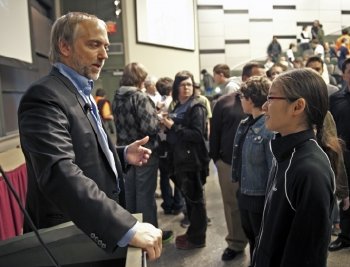Jan 25 2012
On Monday, high school students from across the country assembled in a lecture hall at MIT, patiently awaiting a call from NASA.
For four months, these students worked in teams as part of MIT’s Zero Robotics Challenge, a competition in which high school students program small robots to fly aboard the International Space Station (ISS). The robots, named SPHERES, were originally conceived and built by students in MIT’s Space Systems Laboratory.
 Richard Garriott speaks with a student at the 2011 Zero Robotics Challenge.
Photo: William Litant
Richard Garriott speaks with a student at the 2011 Zero Robotics Challenge.
Photo: William Litant
These robots — roughly the size and shape of a basketball — run on compressed gas, and can be programmed to spin, revolve, hover and navigate through the air. In 2006, astronauts brought several of them aboard the ISS; a few years later, astronaut Greg Chamitoff PhD ’92 helped launch the Zero Robotics Challenge, making the robots accessible to high school students.
Chamitoff was on hand Monday, along with several colleagues who served as mentors during the challenge: former astronauts Leland Melvin, John Grunsfeld ’80 and Jeff Hoffman, now a professor of aeronautics and astronautics at MIT.
For this year’s challenge, students were given a “mission” to program robots to look for, mine and return alternative energy from fictitious asteroids in deep space. They were given coordinates for virtual asteroids located within the ISS and then had to develop computer codes to make a robot perform using various strategies, each of which earned a certain number of points.
For the past few months, student teams have been testing their codes in computer simulations, maneuvering virtual robots and competing against other teams in online games. The finalists — 38 teams with the best simulation scores — assembled at MIT on Monday for a chance to watch their codes play out in real robots on the ISS, 250 miles above Earth.
The students gathered in MIT’s 10-250 lecture hall. Many sported uniforms, including one team clad in NASA’s “pumpkin suit” orange. Once NASA successfully connected MIT with the ISS, a large screen at the front of the hall projected a live view from inside the station — and 10-250 erupted in cheers. Astronaut Don Pettit, onboard the ISS, responded, “We hear you loud and clear, MIT.”
Pettit and his colleague Andre Kuipers served as referees during the game, monitoring the robots, keeping score and occasionally pausing the game to refuel: Several times, the robots literally ran out of gas, and the astronauts rummaged through the ISS module’s storage bins for extra tanks of carbon dioxide.
Despite a few glitches in the video feed, most teams were able to watch their algorithms in action. During each match, both a red and a blue SPHERE began their missions simultaneously, slowly circling each other and moving about the module according to their preprogrammed trajectories.
“The coolest thing is not just that they’re controlling these robots onboard the ISS,” Melvin said. “In the future they may be developing algorithms to do inspections on the outside of the space station, or they may program robots to help vehicles dock. These are some really good skills that will help us down the road with NASA’s future missions.”
During the championship round, the video connection blinked out, leaving only a live audio feed. The astronauts continued running the final teams’ codes, and Pettit offered to narrate each round.
“They’re stabilizing at 50 centimeters and closing,” Pettit reported to the earthbound crowd. “Are they going to crash? They just missed each other! It looks like they’ve completed … and we have a score!”
The winning team — dubbed “Team Rocket” — comprised representatives of three high schools in Maryland, New Jersey and Florida. The team’s mentor, astronaut John Grunsfeld, said the win was a surprise for the students, many of whom had never developed a computer code before this challenge.
“This is just fantastic to see all the students from all the schools and how well they did,” Grunsfeld said. “Hopefully some of them will come to MIT.”